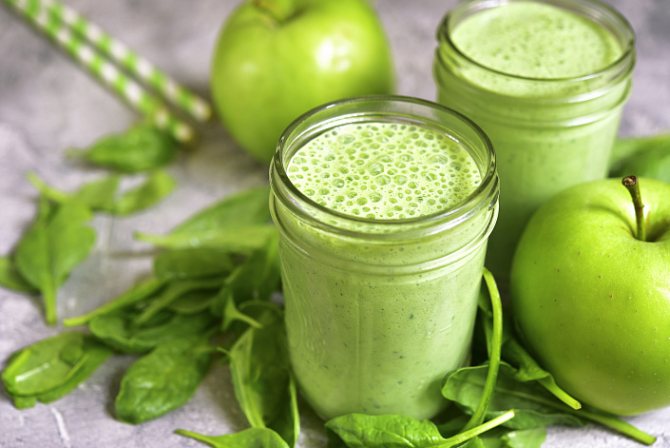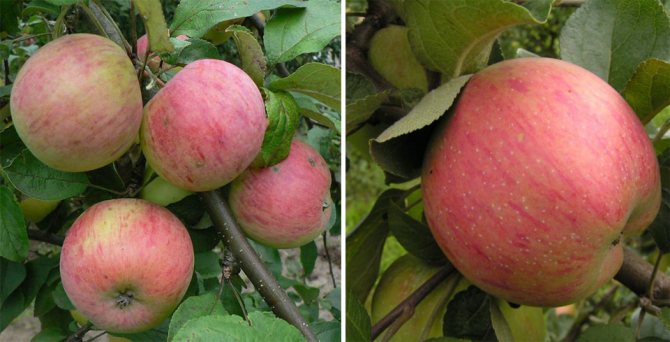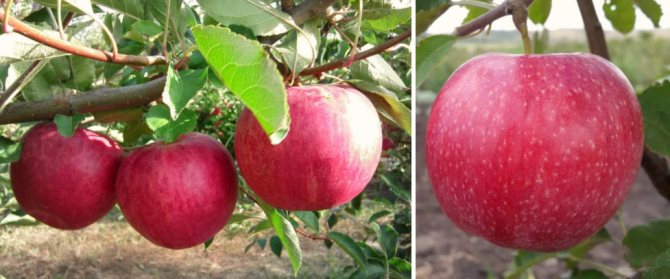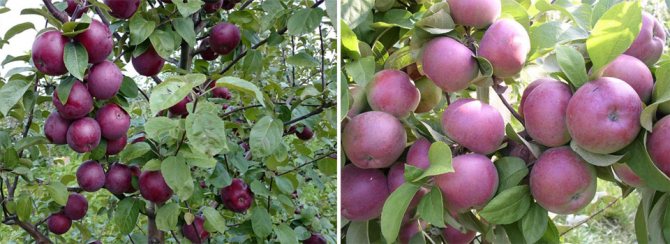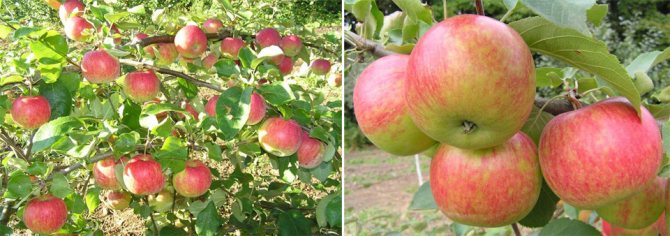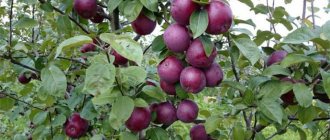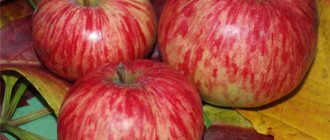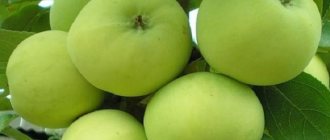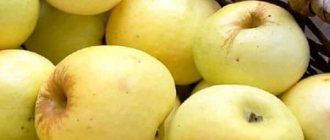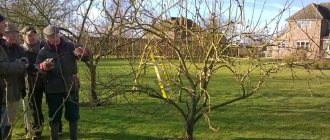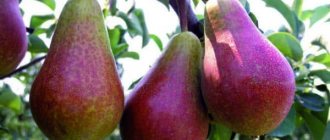The apple tree is an integral attribute of an orchard, a frequent visitor to summer cottages and an honored member of all vegetable gardens. Indeed, apples are used for fresh consumption, and are also great for preparing all kinds of sweet desserts, pastries and compotes. They have many benefits for the body, saturate it with vitamins.
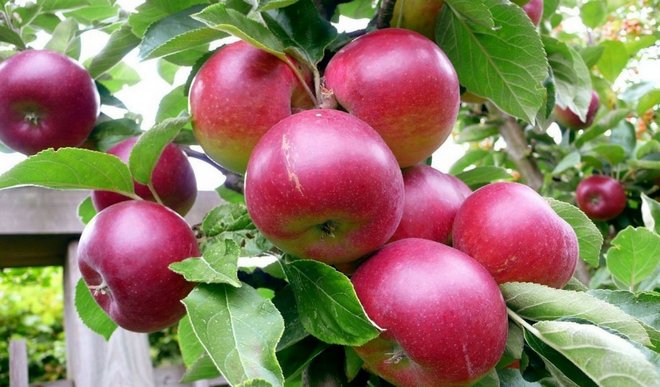
One of the best apple varieties.
In addition, a large selection of varieties and varieties will allow you to choose exactly the apple that suits your taste. Thanks to the varieties, you can provide tasty, juicy fruits all season. They differ in size, collection and storage time, taste, tree species and even skin tone. To understand how to determine the variety of apples that will be most suitable for planting in your own garden, you will need to compare and consider them. This selection contains the best varieties of apple trees that will definitely find their admirer.
The best summer varieties of apple trees
The peculiarity of summer varieties is that they are early maturing. The crop is ready to be harvested in the last month of summer and processed immediately. The fruits on such trees ripen quickly and amicably, almost at the same time. That is why it is required to monitor them so that the crop is not dumped. Varieties can be both chicken and small. It is believed that their vitamin content is maximum.
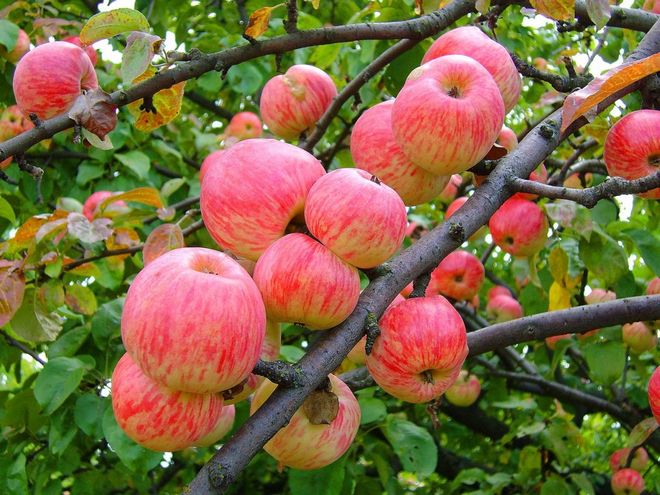

Summer apple variety Melba.
Here is a selection of the best summer varieties:
- Melba. The fruits ripen in August, can be transported, but not stored for a long time. The rounded shape can safely be called correct. The fruit is bright, green with red, pronounced stripes. They are distinguished by their amazing taste, sweet and sour, with a pleasant spice. The tree is not tall, but its branches are sweeping, the crown is dense;
- Early sweet. The tree is not tall, but surprisingly resistant to cold and is not afraid of fungal diseases. The fruits ripen according to the name at the very beginning of the season, their size is average, but the fruiting is abundant. They taste rather sweet, with a slight sourness, which does not spoil them a bit;
- Folding. The peculiarities of the trees of this variety are medium growth, but a rather wide and sweeping crown. They suffer from frost, so you will need to cover them under adverse conditions. But immunity to pathogens of various diseases serves as an excellent defense. Fruits of excellent sweet and sour taste, round, medium size. But they are not kept at all and are afraid of any movement;
- Chinese woman Gold. A short tree becomes weeping as it grows and develops. It is resistant to low temperatures, but it can suffer from and is often affected by fungus under unfavorable conditions. The fruits must be harvested immediately after ripening, because they quickly crumble. Their size is small, but this does not prevent you from enjoying the amazing sweet taste;
- Mironchik. The tree of this variety is distinguished by its resistance to low temperatures. The powerful crown is not afraid of even the strongest gusts of wind. These qualities make it suitable for growing even in the harsh conditions of Siberia. Fruits of medium height, yellowish with dense flesh and unremarkable.But their taste will conquer everyone, it is so sweet and pleasant;
- White filling. Representatives of this variety are deservedly part of the list of the best apple trees. The tree is resistant to low temperatures, easily adapts to climate changes, can simply survive drought and has good immunity. The fruits are beautiful, green-white, of medium size, ripen abundantly, but practically not stored;
- Candy. The apple tree can be grown as a dwarf one. The tree is compact and slow growing. The fruits ripen in mid-summer amicably, although they are quite small. But even the smallest apple has a surprisingly sweet taste.
detailed instructions
Conditions
For prepared fruits, the creation of an appropriate environment plays a significant role:
- A place... It is better to disinfect the basement or other room in which the storage will take place: whitewash the walls with a freshly prepared mixture of lime and copper sulfate (1.5 kg of lime + 150 g of copper sulfate per 10 liters of water); treat the floor in the cellar with a solution of ferrous sulfate (450-500 g per 10 liters of water).
- Storage container... Parameters such as size, shape, construction and material of which the boxes are made do not play a special role. Cleanliness and durability are the main requirements of the container.
Containers must be thoroughly rinsed and disinfected if fruits or vegetables have already been aged in them. - Temperature... Typically, the temperature regime for laying apples ranges from -1 ° C ... + 1 ° C. But a range of + 2 ° C ... + 4 ° C will be favorable for fruits.
- Humidity... The optimal level for storing apples is 85-95%. Low humidity threatens to wilting.
Variety
The selection of a variety is an important stage, which is responsible for the time that the harvest will be stored. Not every apple can preserve nutritional and nutritional properties for a long period..
How to shoot?
To keep the apples in their natural form, it is important to follow the rules from the very collection of the fruits. The shelf life will depend on this.


when ripe fruits begin to crumble 5-6 pieces per day, you can start collecting;- harvesting is possible only in dry weather;
- do not tear off the stalk;
- do not wipe the apples (this will break the wax coating - natural protection);
- you can't throw apples, just carefully put them in a container;
- it is better to start collecting from the lower branches, moving to the upper ones.
Sorting
Before this procedure, it is better to place the fruit in a cool room for a couple of weeks. During the time spent in the chill, defects may appearif any. Next, you need to do the following:
- select for storage only healthy fruits without "abrasions", preferably with stalks;
- separate different varieties for storage;
- calibrate by size: large, medium and small separately;
- do not wash or rub the apples!
After careful sorting, you can proceed to the next step.
Styling
Arrange the apples with the stalks upwards in 2-3 layers. Long stalks must be shortened, this will save neighboring fruits from possible damage. Apples are not stacked.
Thus, it will be easy to detect rot during storage if the fruit begins to deteriorate. The method also allows you to lay a much larger number of apples.
The method is good, but not the best. If at least one focus of decay appears, then the infection will go to the rest of the fruits immediately. You will need to check your bookmarks regularly, which is always convenient.
Paper wrapping
A simple and affordable way, consisting of simple steps:
- Wrap each apple in a paper towel, napkin, etc.
- Place in a box in rows with the stalks up.
The fruit will keep well if it is undamaged.
Pouring


A mixture of washed and dried sand and ash is poured onto the bottom of the box (a layer of about 3 cm). It is important that the sand is washed and dried, and its moisture content does not exceed 5%, otherwise the fruits may start to deteriorate.
Next, the apples are stacked so that they do not touch each other.From above, they are completely covered with the same composition. Multiple layers are allowed. Sand with ash can be replaced with other dry and bulk materials:
- Husked buckwheat.
- Linen frills.
- Onion husks.
- Husk.
- Peat.
- Moss.
- Leaves of trees (dry).
- Shavings of deciduous trees.
- Sawdust.
The apples, separated from each other, perfectly tolerate winter and even spring, the duration of storage is limited only by the keeping quality of the varieties.
Plastic bags
Make 4-5 punctures in the bag for ventilation. Put 2-4 kg of single-breasted apples in it and tie. Store at temperatures between -1 ° C ... + 1 ° C. This method has worked well.
Land
In the absence of a basement, you can store apples in the ground... You need to dig a hole or trench 40-50 cm deep in advance. With the onset of cold weather (about -5 ° C ... -7 ° C), pack the apples in plastic bags of 5-6 kg and put them in the hole.
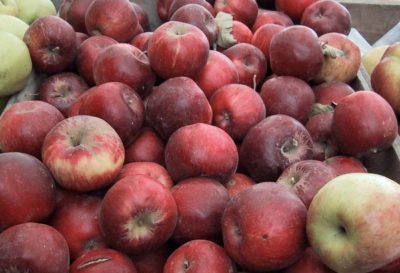

To prevent rodents from entering, it is recommended to cover spruce or juniper branches at the bottom of the trench and on top of the bags. Cover everything with earth. In winter, it will be more convenient to look for your "treasure" if you leave a mark in the form of a stick or a flag.
Apples are perfectly stored underground until spring.... To protect the bookmark from freezing, you can sprinkle fallen leaves on the surface of the pit.
Carbon dioxide treatment
There is another way to keep the harvest in bags for a long time. CO2 is slowly pumped into the bag using a siphon for carbonating the water. At the end of the procedure, the hole is sealed.
Ultraviolet
Resourceful gardeners treat apples with a germicidal ultraviolet lamp (BUF-60) at a distance of 1.5 meters for 20-30 minutes. For uniform irradiation, the apples are laid out in one layer and turned over only once. This method prevents the appearance of rot on the fruit.
The best autumn varieties of apple trees
These varieties are characterized by ripening in the first autumn months. Most often, they can be stored for some time, from two to five months. Often these species are grown in order to sell them.


Autumn variety of apple-tree Anise striped.
In this selection of the best varieties of autumn apples:
- Anise striped. Tall tree with a dense, pyramidal crown. It is not afraid of severe frosts and can withstand slight droughts. The fruits are round, ribbed, with a pretty blush and stripes. The harvest that is collected from a tree of this variety is abundant, can be stored until mid-winter;
- Auxis. Representatives of this variety do not grow tall, but the crown grows thick and spreading. The fruits begin to ripen in early September, they are of a standard size and have a pleasant sweetish taste;
- Bessemyanka Michurinskaya. The tree is very tall, with a dense and spreading crown. It is not afraid of cold weather and fungal diseases. Fruits are medium in size, round or flat, yellow-orange with red stripes. Their taste is very soft and delicate, sweet and sour. The fruits are of high quality, but they ripen unevenly, therefore, if you do not organize careful supervision over them, part of the harvest can be lost;
- Zhigulevskoe. One of the most popular varieties, due to their excellent taste and presentation. The tree is not tall, with a thin crown, but at the same time it is very productive. Fruits are yellow-orange with ruddy red sides. The pulp is tender, juicy, sweet and sour;
- The beauty of Sverdlovsk. A variety that has a fairly high resistance to cold weather and fungal diseases. The tree is medium, round and produces a fairly decent amount of medium-sized yield. The fruit is beautifully rounded or conical in shape, creamy red, even crimson. They keep pretty well until midwinter;
- September. The tall tree with a pyramidal crown is distinguished by its resistance to low temperatures. Fruits of medium size, regular shape, yellow-green, with light stripes.They taste just perfect sweet and sour.
Selection principles
To identify a variety, an examination is carried out. When carrying out this procedure, special attention is paid to the following points:
- The structure of the vegetative parts of the plant.
- Organoleptic type indicators.
- The color and consistency of the pulp.
- Peel structure.
- Determination of the shape of the fruit.
- Fruit size (average).
Large-fruited apples are more popular than small-fruited ones. Ranetki can be considered an exception to the rules. Their flesh is firm.
The best varieties of winter apple trees
A feature of winter varieties of apples is their long shelf life. And after being removed from the trees, their taste is far from ideal. It only gets better over time, and they can be stored even until summer.


Winter apple variety Bogatyr.
Below is a list of the best winter apple varieties:
- Bogatyr. The crown of this tall tree is very sprawling and rare. The fruits are harvested in autumn, they become the most delicious by the beginning of winter. The fruits are large, tasty, green, turn yellow during storage, a reddish blush appears;
- Aphrodite. The fruits have the great name of the goddess, because in fact they are distinguished by their beauty. They are medium in size, wide-ribbed, yellow-green with reddish-crimson stripes around the perimeter. It should also include excellent taste, sweet and sour apples, with an ideal proportion of the entire range of flavors;
- Bezhin meadow. The tree is resistant to low temperatures, does not suffer from the invasion of fungi and pests. Medium-sized fruits are oblong and ribbed. They taste sweet and sour, soft and tender. Well stored and transported;
- Berkutovskoe. The cultivar is an excellent drought and cold tolerant tree that is usually of medium height, but can grow above average, although the crown is quite compact. The fruits are rather large, well kept and ripen abundantly. They have a rounded shape, soft yellow-green flesh with a sweet and sour taste and green skin, with many red stripes;
- Veteran. A productive variety with high resistance to fungal infections. There are quite a lot of fruits, they are of medium size, flattened in shape. The shade of fruit is yellow-green, the pulp is juicy and sweet;
- Health. Apple trees of this variety are tall, with a dense round crown. They give a large amount of harvest. Fruit of the correct shape, yellow-green in color, with blurred red stripes. The advantages of this variety are resistance to cold weather and pathogens;
- Kuibyshevskoe. Not just tall, but a very tall tree with a thin crown. The apples are medium in size, but there are a lot of them, and they are densely planted, as if strung on a branch. The taste is simply excellent, sweet and sour, soft pulp is tender and juicy;
- Lobo. The plant is of medium height, with a sparse crown shape. The apples are medium in size, beautifully rounded with light ribs. A shade of green with rich crimson blotches, which become solid over time. The harvest is stable, well kept and distinguished by its excellent taste;
- Orlik. A compact tree of medium height, with a neat crown. It is not afraid of severe cold weather, so it can be grown in cold winters. But in order for the apples to ripen and survive, you need enough heat until September. Productivity is quite high, apples are of medium size, regular shape, with juicy pulp of sweet and sour taste;
- Sokolovskoe. This tree is dwarf, with a horizontal crown, but at the same time it is quite fruitful. Fruits are medium, yellow-green, with a slight red blush. Fruits are of high quality and commercial characteristics, however, they gain their advantages only with a sufficient amount of moisture;
- Welsey. A medium-sized tree has a fairly wide, spreading crown. The harvest is plentiful, well stored and transported.The fruit is medium in size, round to turnip, yellow with red stripes.
Dwarf
Dwarf apple trees are not really like that because they are created as such, but because certain varieties are grafted onto the right stock. They grow into dwarf and semi-dwarf trees, which sometimes can reach 3-4 meters in height. In fact, this is an ordinary apple tree, with the same crown and simple types, and is completely unlike the columnar one.
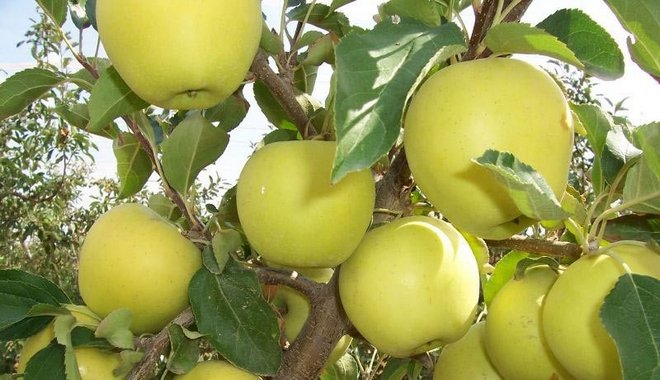

Dwarf apple variety Golden Dilishes.
Dwarf varieties have several advantages. One of them is the convenience in processing such trees. Due to their convenient growth, it is easy to remove fruits from them, they are easy to spray and cut. The yield on this growth of trees appears faster than on ordinary trees and there is more of it. Trees have the same lifespan as other cousins, but they can survive in more volatile conditions.
Here are some of the very best dwarf apple varieties:
- Golden Dilishes. Although this variety is summer, it ripens quite late and can lie until the middle of winter, for which it is often called autumn. A tree with a dense and leafy crown. The taste of the fruit is also distinctive - it is real apple, sweet and sour, but with an interesting note of lightness and freshness;
- Darunok. The representative of Belarus is semi-dwarf, does not grow more than 4 meters, but this does not prevent him from producing a large number of fruits. The variety is resistant to frost, including spring, is not afraid of temperature extremes;
- Grounded. A low tree up to 2.5 meters per rootstock yields abundant fruits within a couple of years after grafting. The fruits can grow rather large, they have an attractive yellow-green color and ruddy red sides;
- Silver hoof. The tree does not grow more than three meters, but it is distinguished by its resistance to adverse weather conditions. The fruits are very beautiful and tasty, although small in size;
- Imrus. An autumn fruitful variety with good immunity to common pathogenic viruses. Large fruits of ideal shape, sweet with sourness. Stored without loss of taste for several months;
- Antonovka. The variety is quite fruitful, resistant to cold air and severe frost. This variety is one of the foundations for many different varieties and hybrids. The size of the fruits is medium, they taste pleasant, sweet and sour, slightly spicy with a persistent aroma.
Care features
Late varieties of apple trees need proper care. By providing good care and attention, you will achieve maximum productivity and rapid growth.
Watering
The garden must be watered at least four times throughout the season.
- The first moistening is carried out in early spring (before the onset of swelling of the buds).
- The second - before flowering, then one day after the week.
- The third is at the stage of pouring the fruits so that they grow large and juicy.
- The last time they are shed with water a month before the onset of stable autumn frosts, which will increase the frost resistance of trees.
Loosening and mulching
The first procedure provides good moisture and breathability. Loosening the next day after moistening.
Mulch is applied to protect the soil from rapid drying out and prevent weed growth. Rotted manure or peat is used.
Fertilizers
An important role for the orchard is played by regular feeding with organic matter and minerals. You need to fertilize three times per season.
- In early spring, a bucket of rotted manure or compost is introduced under the near-trunk zone.
- At the flowering stage, sprinkle with superphosphate and potassium sulfate - 350 g of each component per tree.
- The same composition is used in the fall, about 3-4 weeks before the first frost.
After feeding, abundant watering is carried out in order to improve the quality of assimilation of active substances.
Pruning
Sanitary haircut in early spring is a mandatory procedure for caring for an orchard. All diseased areas damaged by winds, frosts and diseases are cut out to healthy wood.
To avoid infection, the cut off places are irrigated with copper sulfate, then covered with garden pitch.
It also requires cutting branches growing inside the crown and at the wrong angle, which will provide good ventilation inside.
Additionally, shaping is carried out - immediately after planting, the central conductor is cut by 20 cm in height.
In the next season, the trunk and skeletal branches are trimmed to 1/3 of the length, the young growth is cut out, leaving the three strongest shoots of the first order.
In the third year, the branches of the second row are formed from two thick and healthy ones, the rest are to be cut.
Preparing for winter
Young apple trees up to three years old must be insulated. A month before the onset of frost, the near-trunk zone is mulched with peat or garden soil, then wrapped with a film and a chain-link on top. This will protect the trunk from damage by rodents.
The above-ground part is covered with burlap or cardboard boxes, roofing material.
They remove the shelter in the spring, when the street temperature stabilizes at around 5-7 ° C.
Prevention of diseases and pests
Most late-ripening apple trees have good resistance to sores, but many gardeners, for safety reasons, carry out several preventive treatments with copper sulfate or Bordeaux liquid:
- in the spring before the beginning of the growing season;
- before flowering and two weeks after the end;
- in the fall, when the tree has shed its leaves
Additionally sprayed against parasites - Fundazol, Skor, Karate, Aktellik or Aktara. Three such treatments are required per season - at the end of March, 7 days before the start of budding and 10 days after it.
All procedures are carried out in the evening, when the weather is dry and cloudy.
The sweetest
Choosing which apple tree to plant for their own garden or for sale, everyone relies on their own desire. Someone prefers large, others small, sour, sweet or juicy. People say that for every product there is a merchant.
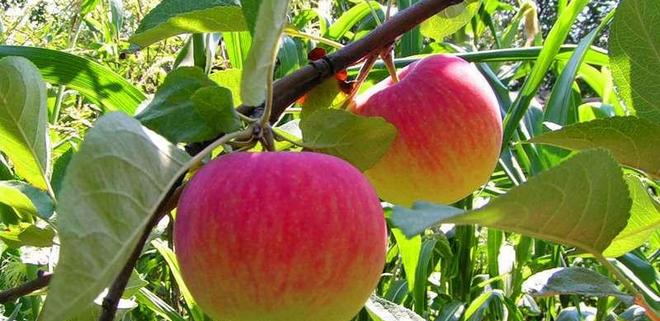

Sweet apple variety Medunitsa.
This selection contains a list of apple varieties that are considered the sweetest.
- Lungwort. This variety is one of the most favorite among modern gardeners, although it has been popular since the days of the Soviet Union. The tree is large in size, quite resistant to external influences and very hardy. The fruits are beautiful, round, yellow with red blotches and very sweet with an amazing aroma;
- Candy. A medium-sized tree with a spreading and powerful crown. Fruits are round, regular, orange-reddish. Honey and caramel - this is how you can describe the aftertaste of sweet fruits;
- Belarusian sweet. Medium-sized tree with good annual fruiting, genetically resistant to rot. Apples are medium-sized, yellow with a red blush, well stored until mid-winter;
- Pepin is saffron. The representative of this variety is wintry, tasty and sweet, but only after it is ripe. The pulp is juicy, its taste is real dessert, creamy. But the whole spectrum of taste and aroma of fruits is gaining by the beginning of winter;
- Delight. The name speaks for itself. The tree is quite powerful, although its growth is low, but the crown is spreading. Harvesting begins in September, stored without loss of quality until the end of the year. The pulp is sweet, with a dense raspberry aroma.
Corresponding position
Correct position preparation should begin at the end of the summer. If you intend to plant more trees or orchards, you need to remember the correct location. The correct seedling spacing will depend on the vigor of the individual varieties. Those who have been vaccinated on dwarf rootstocks or engineered to form spindle-shaped crowns will be able to grow more densely than growing varieties.


The optimum row spacing is approximately 3.5 m.Depending on the strength of the variety, the distance between apples in a row will vary from 1.5 to 3 meters.
Maintaining the correct distance between individual seedlings will make it easier for us to access them during treatment and subsequent harvests. The place where we plant apple trees must be well lit to ensure proper ripening of the fruit.
Red varieties
Red apples are in no way inferior to any others in their taste and breadth of application. Only their appearance is bright and catchy, eye-catching. Like all varieties of apples, among them there are winter, summer, autumn, sour and sweet, soft and hard.
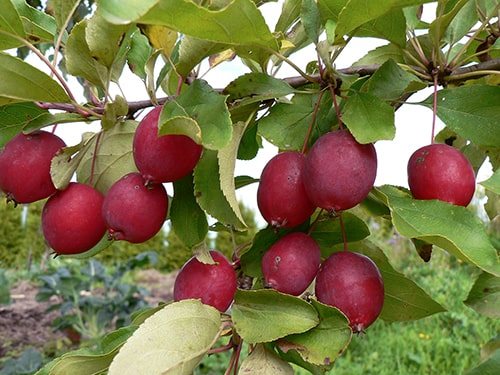

Red apple variety Kitayka Long.
Here are the best of the bright apples:
- Kitayka Long. The oblong-shaped fruit is completely red in color, but small in size. They are practically not stored, taste with a slight sourness and plum aroma.
- Mac. It is also called Macintosh or Autumn excellent. The fruits of this tree are medium-sized, red in color with small green blotches. The taste is sweet and sour, juicy;
- Titania. Columnar tree variety with fairly tall growth and good immunity. The apples are small, sweet and tasteful, and can be stored for no more than 2 months. They have a very attractive shade, dark red, close to cherry;
- Spartan. Winter apples can be edible even immediately after being removed from the tree. But they are stored very well until the beginning of spring and even its middle. The skin of the fruit is firm and firm, red with a purple tinge;
- Florina. The fairly thickened crown provides an average yield of small apples. They are completely red with yellow dots, but in fact their main color is yellow, and the blush is bright. The pulp tastes rather sweet, but is edible only fresh;
- Jonathan. A very common tree has a compact size, but a rather spreading crown. Fruits are red in color with small and dull orange gaps. This winter species is very valuable for its excellent taste, which lasts until spring.
Testimonials
Alexander. “There is a lot of trouble with many new varieties: now they are soaked, then they are frozen, then there is something else I don’t like. With Yellow Sugar, everything is simple - it grows and is not capricious. "
Svetlana. "The tree, of course, takes up a lot of space, but the apples are too good - both fresh and dried."
Andrew. “Five years before the first harvest is a lot. But if you just take care of it, the apples are delicious and the tree will serve more than one generation - you can wait. "
Alexei. "The main thing is to buy a normal planting nursery in a special nursery, otherwise you will wait five years, and you will not get Yellow Sugar at all."
Green varieties
For lovers of the classics, a list of apple varieties that have a green peel has been compiled. It contains chlorophyll, which helps to boost immunity and stimulate the production of red blood cells in the body.


Green apple variety White filling.
Below is a list of the best of the green varieties:
- White filling. Although the shade of the fruit can vary from green to yellow during full ripeness, it is customary to call it white. A familiar and beloved summer variety for universal use, which requires special attention during collection;
- Antonovka. Also one of the classic varieties among apples, on the basis of which a large number of hybrids have been bred. Fruits are green with a dense skin, turn yellow over time. The shelf life is no more than 40 days. The taste can be described as classic, sweet and sour;
- Kutuzovets. A variety with round and rather large green fruits. The pulp is white, soft, sweet and sour. The tree easily adapts to cold climates, tolerates frost and recovers well after any damage;
- Bratchud. A variety with small trees, but with a decent yield. The peel of apples is green, and the flesh is white, sweet and sour. The tree is frost-resistant.The crown is spreading, but horizontal, which makes it very convenient for removing all the fruits.
Sorting apples before storing
Only apples are laid for storage without damage, dents, not wormy. Each apple should be carefully examined and checked for scratches, wounds, everything is in order with the stalk (if there is no stalk, the fruit will soon deteriorate due to fungal diseases). The wax bloom preserved on the apple will be a big plus.


All apples that do not pass this difficult selection can be sent for processing, there will be no sense in storing them. At the time of selection, we recommend that you immediately sort the apples by size. Large apples are more mature than medium and small apples of the same variety and release a large amount of ethylene during storage. Ethylene accelerates the ripening of other fruits, and this cannot be allowed.

